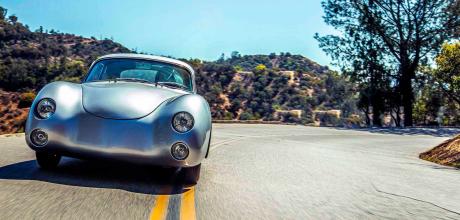Dean Jeffries 1957 Porsche 356 Four-Cam Custom
Dean Jeffries is quietly legendary in hot rod circles. This Porsche 356 four-cam suggests the volume should be turned up. Words Jay Harvey. Photography Evan Klein.
‘IT’S SAID THAT THE PORSCHE WON MORE THAN 30 FIRST-PLACE TROPHIES AT CAR SHOWS AROUND THE AREA’ DEAN JEFFRIES QUAD-CAM 356
LOUDER THAN LIFE
This is not the Porsche that Dean Jeffries is known for. That Porsche, a 550 Spyder on which Jeffries had painted the number 130 and the words ‘Little Bastard’, came to its end about a month later as a rumpled heap along Highway 46 in central California, the brief life of a young screen phenom ebbing away in the wreckage.
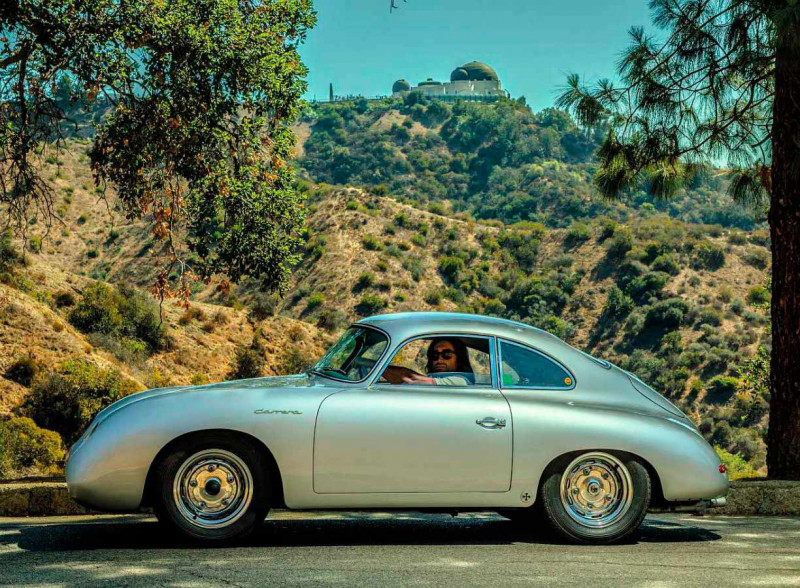
No, the Porsche pictured here was Jeffries’ own, taken in trade in 1957 when he was a rookie customiser with not much to his name other than his well-greased pompadour, doodling with French curves and loading paint guns in a rented workspace behind George Barris’s shop in south Los Angeles. Jeffries customised the Porsche with some hot-rod glosses, then sold it on for a bag full of cash, the car subsequently taking a wild ride across America that only a Hollywood screenwriter could concoct. Now the car is back in Los Angeles – indeed, parked just a few blocks from where it all began.
And where it all began was at long-gone cruiser joints such as Piccadilly’s Drive-In on Sepulveda Boulevard in Culver City, home of the ‘Juicy Jumbo Hamburger’, where the early rodders of the 1940s rolled in at dusk to tease and taunt each other until it was late enough to go drag without getting busted. George Barris was one, a short Greek guy who had come down from Sacramento to see if anyone would pay him to chop roofs, french headlights, and lay pinstripes. By the time the writer Tom Wolfe made Barris famous, in his 1963 Esquire magazine piece ‘the Kandy-Kolored Tangerine-Flake Streamline Baby’, Barris was an institution in the underground world of custom car building. Apprentices were streaming into his shop in Lynwood like students migrating to the feet of the master, with, as Wolfe wrote, ‘their blowtorches and hard-rubber-mallets, creating their baroque sculpture, cut off from the rest of the world and publicised almost solely by the teen-age grapevine’.
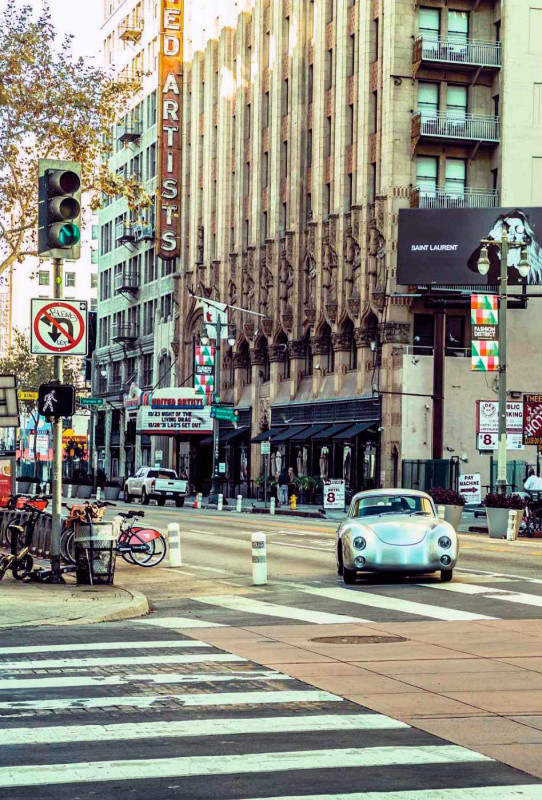
Dean Jeffries was an early pilgrim, the son of a mechanic who was born in Iowa but raised in Compton, just down the street from Barris’s shop. Jeffries was buddies with Kenneth Howard, better known as the pinstriping virtuoso Von Dutch. They went to high school together and were introduced on the street as ‘Von Dutch and the Kid’. Though he never got credit for it, Jeffries was supposedly the first to paint freakish cartoons on cars, before Von Dutch became known for his flying eyeball. Jeffries also airbrushed his designs on T-shirts even as Ed ‘Big Daddy’ Roth got rich selling Ratfink shirts that read ‘MOTHER IS WRONG’ and ‘BORN TO LOSE’.
‘Into Barris’s shop rolled Jeffries in his Porsche, and out came the blowtorch’
‘In the old days it was beautiful,’ recalled Jeffries in a 1970 interview in the Los Angeles Times. ‘People came from all over the country, we had them piled up for three, four weeks. We’d charge ’em five, six, seven hundred dollars. And they’d just say, “Give me one of those wild paint jobs – somethin’ weird, way out.”’
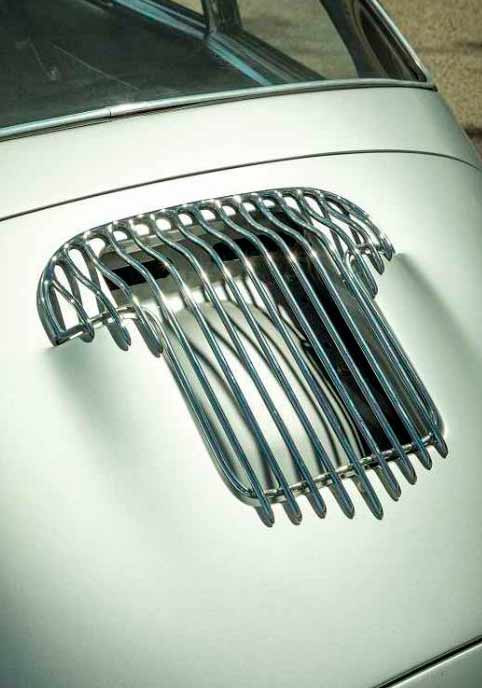
The story goes that Jeffries was there in Barris’s shop in 1957, mixing up Kandy Kolor and painting cars with bulging flaming eyeballs and giant fanged bulldogs, when a kid came in with an honest-to-goodness four-cam Porsche 356 Carrera. Well, either a kid came in with the car and wanted to trade it, or Jeffries bought it from Johnny von Neumann’s Competition Motors, then the Hollywood Porsche (and VW) dealer to the stars. But the first story is better.
Either way, even those with maybe just a passing interest in Porsches back then had heard of the famous ‘four-cammers’. In the summer of 1952, Porsche realised it needed a stronger engine than a Beetle-derived pushrod flat-four if it was to have any hope of dominating sports car racing for the Fatherland. The job was handed to Ernst Fuhrmann, an engineer with a knack for pulling power out of air-cooled lumps and one of the original Gmünd Austrians. Fuhrmann immediately saw the future: not just a racing engine but an engine to define Porsche powerplants in the coming decades. The resulting Type 547 was a way-oversquare 1500cc, 8000rpm howler with four overhead camshafts pushing widely spaced valves and driven by a crazy shaft-and-bevel-gear scheme in the middle of the engine.
‘The fury from the single stinger pipe swells into the mating call of the Mulsanne’
Fuhrmann’s vision of a four-cam road car came into being with the 1956 Porsche 356A Carrera, the 1500GS engine (the G standing for Grand Touring, as distinct from the race-oriented RS engines) making around 110 horsepower through twin Solex carburettors. As in the race cars, the GS engine featured twin distributors firing eight spark plugs, causing some anguished mechanics peering through the small engine hatch of a 356 to grumble that you needed a degree in heart surgery to work on the thing.
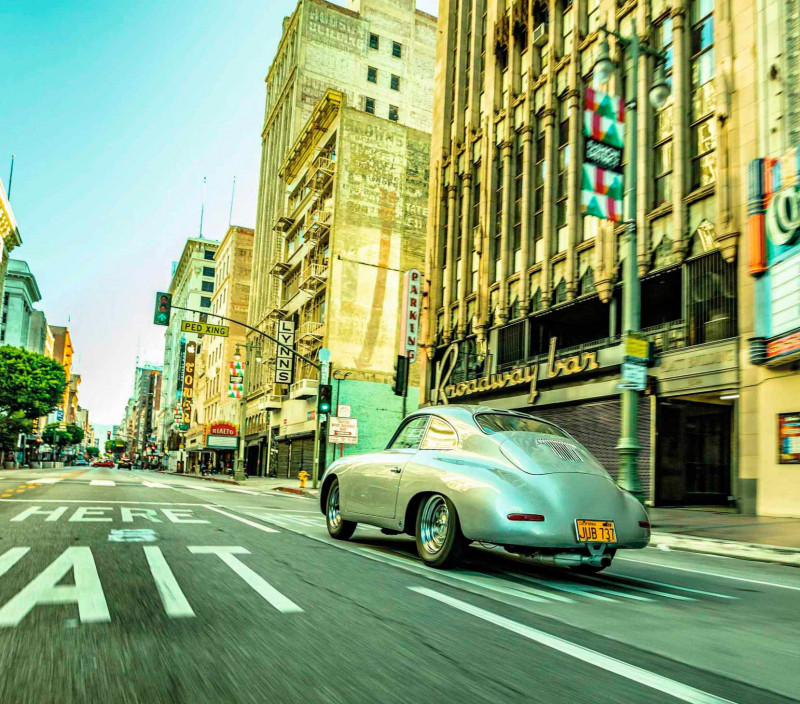
Into Barris’s shop rolled Jeffries in his new, very rare Porsche, and out came the blowtorches and hard-rubber mallets. The bumpers came off and a new nose and tail were fashioned, supposedly with help from Bill ‘The Lead Slinger’ Hines, who in those days came out from Detroit to work in California during the summers. They frenched the headlights – meaning the headlights were inset seamlessly into the surrounding metalwork – as the centrepieces of the fulsomely reshaped front fenders, giving the little Porsche a longer, curvier nose and a rather pronounced set of feminine bazooms. An admirer of the then-new Mercedes-Benz Gullwing, Jeffries cut in a pair of rear-facing roof vents and slotted out the taillights to mimic the big German coupé from behind. He topped it off with his own T-shaped grille for the engine hatch, chromed a bunch of bits under it, then machine-turned all the door sills and engine compartment and even the insides of the tail-light lenses to give the Porsche a definite hot-rod gloss.
It’s said that the Porsche won more than 30 first-place trophies at car shows around the area and made it into some magazines. It helped launch Jeffries’ career and allowed him eventually to move out of Barris’s shop, first to his own place on Sunset Boulevard, then into his final shop, the off-white building on Cahuenga Boulevard between Hollywood and North Hollywood. Angelinos still remember driving past Dean Jeffries Automotive Styling there on Cahuenga and seeing him beating on panels or wrenching on the Ford GT40 Roadster that he somehow talked Ford into giving him for free, and which he left sitting outside by the fence for years.
Sometime in early 1962, Jeffries was offered nine grand in a paper bag for the Porsche by a character named Albert Nussbaum, then on the FBI Ten Most Wanted Fugitives list for knocking over a string of banks with his partner, Bobby ‘One Eye’ Wilcoxson. Their MO was to set off a pipe bomb in a garbage can to distract the cops, then rush into a bank on the other side of town with guns drawn. They were also the prime suspects in a $1.5million mail truck robbery in Massachusetts in 1961, and Wilcoxson, who died in prison in 2006, had already shot to death a bank guard by pumping four slugs into him before the robbery even started. For reasons that can only be imagined, Nussbaum saw Jeffries’ highly recognisable and describable Porsche, at the time painted bright gold, as the ideal getaway car. After they concluded the deal, Nussbaum and Wilcoxson used the Porsche for a spree of robberies during a rollicking road trip from California to Florida. Finally arrested in Buffalo later that year – his own mother-in-law tipped off the cops – Nussbaum served 16 years of a 40-year sentence in the pen, during which he launched a writing career, eventually becoming a published crime novelist, syndicated book reviewer, and TV writer. We said this story has some twists to it.
The Porsche disappeared for a while; current owners Mark and Jay Wiener figure it was probably sitting in a Government impound yard. It resurfaced in 1966 with a tired engine that got replaced by a pushrod 356 motor, then it passed through a few more hands. In 1971, a collector and racer named Jack Walters got hold of it, painted the car white with a blue stripe, and located a new four-cam engine for it from a 550 Spyder that raced at Sebring in 1955 – you know, back before one of those engines would set you back more than $200,000. Years later, in the 2000s, when Walters began restoring the car, he traded the engine back to the Spyder owner in exchange for a freshly rebuilt 1600cc four-cam, the engine that is in the Jeffries Porsche now.
The car turned up at an auction during the Pebble Beach week in 2018, which is where the Wieners found it. Born and raised in Los Angeles and having an encyclopaedic knowledge of its streets and post-war history thanks to working in the family real-estate business with their dad, Mel, the Wieners were immediately attracted to the Porsche. OK, that’s not exactly true. ‘We were just bored at Monterey one year, so we raised our hand,’ admits Jay.
But the closely bonded brothers, who are in their 30s, are interested in Southern California’s car culture. They can recite the locations of all the old hot-rodder shops down to the exact addresses, and they love the local angle of the Porsche. In fact, the garage where they keep the car along with an eclectic collection of antiques and hot rods is just a couple miles from the site of the old Piccadilly’s Drive-In, now a Chevron service station. ‘It’s back in its original home now,’ says Jay, ‘and the journey to get here is incredible.’
Mark and I jump in the well-travelled Porsche and, after waiting out a warm-up of a spitting, lumpy idle, blast up the winding boulevard where the old road parallels the clogged freeway through LA’s Sepulveda Pass. Down low, the flat-four clatters like any 356’s – or indeed, any Volkswagen’s – but, once the fuse is lit at around 3000rpm, the fury from the single stinger pipe swells into the mating call of the Mulsanne.
This is no gussied-up Beetle mill; it’s a full-zoot race motor and, with it pushing from the back, the feather-light 356 darts and squirts through traffic with hilarious agility. Does all the extra lead in the nose affect the car’s handling? It’s hard to say without another Carrera to drive back-to-back, but it doesn’t seem to.
The inside of the Jeffries Porsche has fringes of black patina accenting the weathered dash, a treatment done at Jeffries’ own direction when the car was being restored before Jeffries died in 2013 at the age of 80. When we return to the garage, I ask the brothers, who own other, more original 356s, if they think Jeffries improved the car. ‘He made it one of a kind,’ says Mark after thinking a second. ‘He made it his own.’
Which, given the current valuations of four-cam Porsches, is something very few owners would dare do today.
If Jeffries remembered the Porsche, he didn’t talk about it much in his later years. It was an early step in a career that saw him build more recognisable cars such as the Monkee mobile, the Green Hornet’s Black Beauty, the James Bond Moon Buggy from Diamonds Are Forever, and the bubble-canopy, stiletto-shaped Mantaray, a 1963 dream car that mixed a pre-war Maserati race chassis with a Cobra engine and was perhaps Jeffries’ magnum opus as a customiser.
‘He didn’t talk about himself or promote his work,’ said comedian and collector Jay Leno upon Jeffries’ death. ‘We work in a town where the squeaky wheel gets the grease. That wasn’t Dean. He’s just a regular car guy who happened to create some of the most gorgeous cars you have ever seen.’
Indeed, reminiscing in 1970, Jeffries didn’t mention any of his famous works or the Porsche, but rather his flame-job ’47 Mercury. ‘I had a big screaming head painted on the deck, the horn was a giant mouth, on the gas tank was a little dude dropping in a match – now there was a car!’
Left Four-cam flat-four is something of a Holy Grail in 356 circles, the result of a bid for motorsport success – making this a raregroove car indeed for transformation in a 1950s custom shop. Left and right Weathered dash and machine-turned trim more vivid than on most 356s; front end is modified with frenched headlamps and more curvaceous fenders; T-shaped grille in engine cover was also Jeffries’ own work.
Right The 356 with a difference: tail-lights and vents above rear screen were inspired by the Mercedes Gullwing, a car Dean Jeffries admired.


